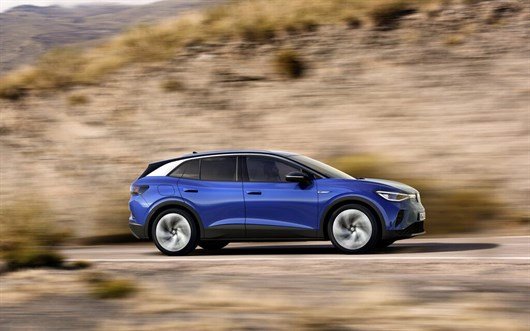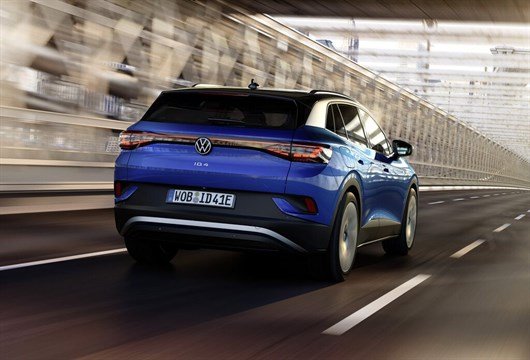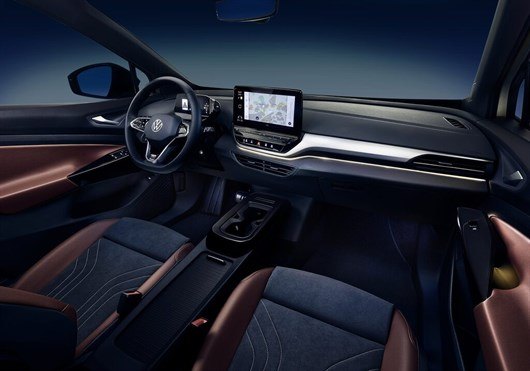Volkswagen launches electric ID.4 crossover

Volkswagen has revealed the new ID.4, which joins the ID.3 in the firm’s burgeoning all-electric ID line-up.
Prices are expected to start in the region of £45,000 when the ID.4 reaches showrooms in late-2020, but the electric crossover will qualify for the UK government’s £3000 grant for low-emissions cars, which may lower the price to £42,000.
Despite its SUV-like looks, the ID.4 is rear-wheel drive (a four-wheel-drive model is planned for 2021) with an electric motor producing 204PS and a 77kWh battery – a combination that translates into 0-62mph in 8.5 seconds and a range of up to 323 miles.
You can charge the car from empty in 30 minutes using a 125kW fast charger, alternatively, Volkswagen will install a home charger for around £350, which takes four hours for a full charge.

Volkswagen is claiming the ID.4 will be sporty to drive – thanks to its balanced weight distribution and low centre of gravity. However, you can also expect it to be a very easy car to drive in town. It has a tight 10.2-metre turning circle, a raised body that’ll have plenty of clearance over speed humps and regenerative braking that slow the car when you take your foot off the accelerator pedal, so you rarely need the brakes.
A suite of driving aids means it can drive itself on the motorway so long as you keep your hands on the steering wheel.
Styling follows the ID.3 mould. There’s no need for a conventional radiator so you don’t get one, the bonnet is low, sharp creases run nose-to-tail and there's a broad C pillar. Both the front and rear lights can perform a sequential dance when you unlock the car, whereon – in true Tesla fashion – the flush door handles pop out so you can get in.
The modern theme continues on the inside, where you get a digital instrument binnacle and a large centre screen that’s up to 12 inches in size. There are very few conventional buttons, so the car has a clean, fuss-free design.

As you’d expect, the infotainment features Apple CarPlay and Android Auto – so you can use your phone’s apps on the car's big screen – and it will also understand colloquial voice commands. Well, that’s the theory.
The ID.4 goes a step further than all cars – bar the ID.3 – with augmented reality sat-nav that can superimpose directions onto the road by projecting them on the car’s windscreen. It looks cool but is also highly intuitive.
Meanwhile, the ID.Light is supposed to inject a Herbie-like character into the car by using a strip of colour LEDs in the dashboard to communicate with you. It can do things like flash red if you need to make an emergency stop or turn cool shades of blue to signal icy road conditions. It's similar to the light-up bezel you get in the MINI 3-door.
Along with the clever gadgets, you can expect the ID.4 to be strong on practicality. It's slightly bigger and has a longer wheelbase than a Volkswagen Tiguan. Boot capacity sits at 543 litres with the seats up (the Tiguan has 520 litres) and 1575 litres with them down. The ID.4’s 1000kg maximum towing weight is significantly down on what you’d expect from a conventional SUV though.

The ID.4 will initially go on sale in Germany where it will be offered as two models – the ID.4 1st and the ID.4 1st Max. The former comes with kit including 20-inch alloy wheels, heated front seats and steering wheel, ambient lighting with 30 colour options, two-zone climate control, a rear-view camera and Discovery Pro sat-nav with a 10-inch centre screen.
As the name suggests, the ID.4 Max model has all the options ticked. It adds LED matrix headlights, 3D led tail lights, 21-inch alloy wheels, illuminated door handles, adaptive dampers and progressive steering that has fewer turns lock to lock.
You also get a glass roof, acoustic glass, electrically adjustable seats, three-zone climate control and an electrically operated boot lid. Upgraded infotainment constitutes a 12-inch centre display with the aforementioned augmented reality sat-nav.
Both “limited-edition” cars are restricted to a total of 27,000 units. Once they have sold out, they will be followed by pre-configured models which bundle the options that are most popular on the market into packages – there's no word on exactly what specification they'll have.

 Russell Campbell
Russell Campbell
 Honest John Awards 2017: Land Rover Discovery Sport named Most Popular SUV for second year in a row
Honest John Awards 2017: Land Rover Discovery Sport named Most Popular SUV for second year in a row
 2022 Smart #1 SUV: price, specs and release date
2022 Smart #1 SUV: price, specs and release date
 2023 Ferrari Purosangue SUV: Prices, specs and release date
2023 Ferrari Purosangue SUV: Prices, specs and release date
 Citroen DS3 Racing revealed
Citroen DS3 Racing revealed
 Infiniti adds diesel to the range
Infiniti adds diesel to the range
 Volvo XC90 chosen as SUV of the year at 2014 Honest John Awards
Volvo XC90 chosen as SUV of the year at 2014 Honest John Awards
 March new car registrations better than expected
March new car registrations better than expected
![2023 Volkswagen ID.4 150kW Max Pro Performance 77kWh 5dr Auto[135kW Ch]](http://images.honestjohn.co.uk/imagecache/url/crop/90x60/https/img.common.prod.group-mobility-trader.com/unsafe/1200x/filters_COLON_quality(60)_COLON_no_upscale()/cdn.uk.prod.group-mobility-trader.com/images/fallback/coming-soon.jpg)
![2023 Volkswagen ID.4 109kW Life Pure 52kWh 5dr Auto [110kW Ch]](http://images.honestjohn.co.uk/imagecache/url/crop/90x60/https/assets.heycar.co.uk/t_default-export/f_auto/application_assets/vehicles/pictures/91486f26bfc80816c33d2085ee317f85/2a2c250a74614f6fab007503e599e4f6.jpg)



.jpg)






gavsmit on 25 September 2020
From £45,000? They can get stuffed!The first manufacturer that releases a realistically priced practical EV will clean up - and good luck to them now most manufacturers are slapping ridiculous prices on not just their EVs but ICE cars too.
conman on 26 September 2020
Before anyone is kidded into believing the manufacturers figures please look at the specifications supplied by the Electric Vehicle Data site for the real figures. it's amazing the Id3 figures are supplied below for the smallest Battery. Real Range Estimation between 120 - 250 mi City - Cold Weather * 165 mi Highway - Cold Weather * 120 mi Combined - Cold Weather * 140 mi City - Mild Weather * 250 mi Highway - Mild Weather * 155 mi Combined - Mild Weather * 195 mi£25,000 * Price from 25K 45.0 kWh Useable Battery 170 mi * Real Range 260 Wh/mi * Efficiency After closer inspection that magical 250 miles seems to be optimistic. Just ask your self in 5 years when batteries have improved who will want to buy a vehicle with a worst range forecast of 120 miles.
Also before you buy, just check with your electric company if you can have the increased charger power in your area.
You can charge the car from empty in 30 minutes using a 125kW fast charger, alternatively, Volkswagen will install a home charger for around £350, which takes four hours for a full charge.
Edited by conman on 26/09/2020 at 10:28
lemmy on 28 September 2020
Honest John does a useful comparison from time to time between what car makers say is the MPG of their cars and what readers actually get in the real world.It would be good to do a similar comparison with EVs. Here's the makers projected range. Here's what owners actually get.
An EV may do 250 miles on a charge in steady speed, light load country conditions. A very different story on a wet Friday night in London, A/C/heating on, wipers on and stop start progress.
Rory Choudhuri on 28 September 2020
Yet again, stats from people who don't understand EVs.
There's no way that you'll charge from empty to full in 30 minutes, not even on a 125kW charger, if you can find one. The rate of charge will tail off as it fills. You might be able to go 0-80% in that time, perhaps even 90%, which is enough to continue your journey. Rapid chargers are already being hogged by people who don't understand this, and sit there for hours waiting to get to 100%, when it would be much quicker and more efficient to fill to ~80% and carry on.
Almost all home chargers in the UK are 7kW chargers. With a 77kWh battery, that's 11 hours from empty to full. I have no idea how you can claim 4 hours!
In the fairly rare (in the UK) instance where someone has three phase power at home, two things change. The home charger to be installed will cost significantly more than £350. Also the car can only take 11kW, so it would still take 7 hours.
jchinuk on 29 September 2020
Rory is quite correct.You can try this with any rechargeable device, charge your phone or drill, it will reach "maximum charge" (ie the red charging light will go green), but switch it off and on again and charging will resume.
GTC20th on 28 September 2020
I'm guessing these manufacturers make many of their EVs as stupid, wobbly SUVs because it's the only way they can squeeze in enough batteries to give even mediocre range. Plus making jacked up hatchbacks is a good excuse for inflating the prices.Not for me, but when they make a decent sized hatchback SUV with a range of 250+ miles and a price of sub £25k I'll think about it.
jchinuk on 29 September 2020
Given the current economic situation, I'll not be surprised if the "electric car subsidy" disappears pretty quickly. On paper, it just looks like giving rich folks money to help them buy a car.On this particular model, of more interest is that the VW ID 'skateboard' will form the basis of new models from Ford, surely more keenly priced.
f1kwa on 29 September 2020
Electric door handles, seats, disco lights, tailgate, heated seats and steering wheel etc etc., I wonder what the range would be without so many gadgets? Why is it that car manufacturers adorn their EV’s with so much unnecessary battery draining junk?agedn on 29 September 2020
As this car has in it the same screen as the Golf and SEAT Leon which controls everything including the heating and which is criticised by nearly every road tester as being far more difficult to use that a conventional control knob and requires your eyes to be taken off the road for far too long, I have zero intention of buying this car or any other car which VW group try to foist on the public with this stupid screen. Why do they have this obsession for keeping the dashboard as clear as possible - this is a car for goodness sake, not a living room - and why do I have to put myself and my family at risk because I cant immediately find the right bit of the screen to stab at. In any event there have been numerous road tests where testers have found that the screen crashes - really useful if you are desperate to put a blast of air onto the screen but the wretched thing has frozen or worse. What is wrong with conventional control knobs for the heater and radio, which you can generally reach without looking?So having had a fair number of VWs and Skodas over the years I will definitely not be buying another which has this screen
Add a comment